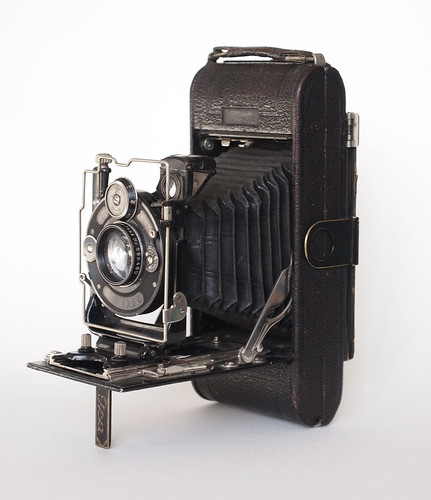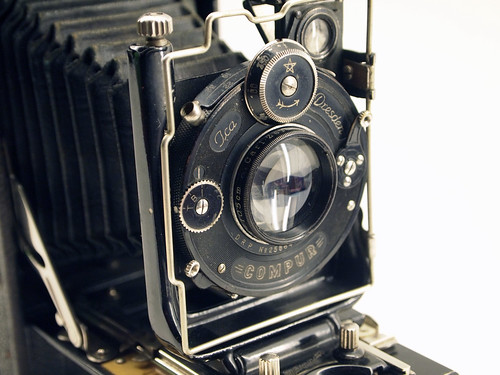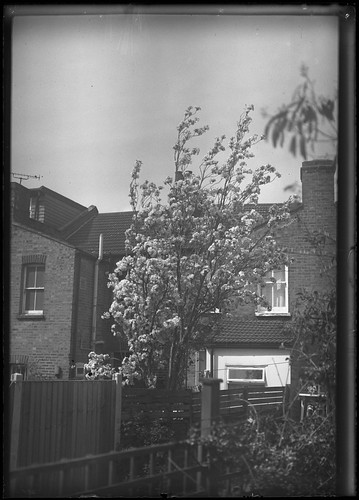 |
| Ica Icarette II/L |
Ica continued many camera models from its constituent companies, but the Icarette line of elegant folding cameras was an entirely new range, using a number of different rollfilm formats, from 127 to 116. The Ica Icarette II (named the Icarette L in US Ica/Zeiss Ikon catalogues) takes 6x9cm size images on 120 film, but it's a dual format camera (as are some of the other Icarette models), meaning that it also takes plates. This makes it a model 500/2: there is an Icarette II which takes rollfilm only, with a model number of 500/1; the Icarette I was a horizontal folding camera in the 6x6 negative format. The Icarette II 500/2 has a section of the camera back with the orange window–and a separate pressure plate–that can be removed and replaced with a ground glass screen and plateholders for 6.5x9cm (or 2 1/2x3 1/2 inch) glass plates (my first post on glass plates discusses the differences between metric and imperial sizes). When loading rollfilm, the camera back removes entirely, and the spool holders on each side are hinged to swing out for ease of loading. The focus scale has to be adjusted to either 'P' for plates or 'F' for film as the focal plane changes depending on which format used. This has a notch for infinity, which the lensboard pulls out to, the Icarette being non-self-erecting, as self-erecting designs for folding cameras only became common in the 1930s. There's also a handwritten focus scale on the other side of the bed for the Distar lens attachment.
 |
| Ground-glass back removed, and plateholder inserted. |
 |
| Icarette L lens detail |
The camera also features double extension bellows, and a rising front. I have found the double extension bellows can cause a problem when focused from infinity to any moderate distance, as most of the length of the bellows remain in the camera's body unless drawn out manually, otherwise they tend to occlude the edges of the frame widthways, blurring them. For a viewfinder, there's the brilliant finder adjacent to the lens, a wire frame sportsfinder, which has an unusual profile to fit around the shutter and permit access to its controls, and the ground glass screen when using plates.
One of the curious features of my Icarette is it has "The Westminster" impressed into the leather on the back of the ground glass screen hood, the rollfilm back and inscribed between the knobs of the lensboard base. This could be The Westminster Photographic Exchange: much like my Baldalux camera rebadged by Wallace Heaton, presumably the Icarette was sold in the UK by The Westminster Photographic Exchange. There's a camera very like the Icarette II in one of the company's advertisments, 'The Westminster' can be discerned on leather on the camera, although on closer inspection, I believe the camera depicted in the illustrations is actually a Contessa Nettel Cocarette (identifiable by the shape of the wireframe finder, catch on the camera body, and the vertical stand).
Although I also have a Wallace Heaton plate camera in 6.5x9cm size, I've only used the Icarette II to shoot my glass plates in this size. Fortunately, my Icarette still had both the ground glass screen and the rollfilm back and pressure plate, as well as a leather wallet with four Ica plate holders and a case. As well as plates, I've also shot a few rolls of film; the Icarette II is not the most convenient of my medium format folding cameras - but possibly has the best lens. The Tessar lens, nearly ninety years old, performs very well. In the examples below, the photograph of the London 2012 Olympic Village in particular shows the good edge-to-edge sharpness of the lens.
 |
| Hackney Downs, Rollei RPX 400 developed in R09 One Shot (Rodinal) 1+25 for 11m15s at 18˚C |
 |
| London 2012 Olympic Village, Fomapan 200, developed in Rodinal 1+50; 8mins at 20 degrees C. |
 |
| Ilford R10 glass plate, stand developed in Rodinal 1+100 |
 |
| Kodak O.250 glass plate, stand developed in Rodinal 1+100 |
Sources/further reading
Icarette models & Ica pages on Camera-Wiki
Ica chronology (in French)
Ica pages on Early Photography
Hi, this is kind of silly, but what is the serial number on your Icarette's Compur? I bought a ICA Trona 110 today and I was looking for info on when it was manufactured. I found this page and looking at the picture I realized the number is very familiar. I picked up my camera and indeed the serial# is 258646. From the picture it looks like your's is 25864X.
ReplyDeleteI think that the number on the front of the faceplate of the shutter (258646) is in fact a patent number (the "D.R.P." stands for Deutsches Republik Patent); the serial number is on the side of the shutter. Mine is 378706, which would date that particular shutter to before 1920.
Delete